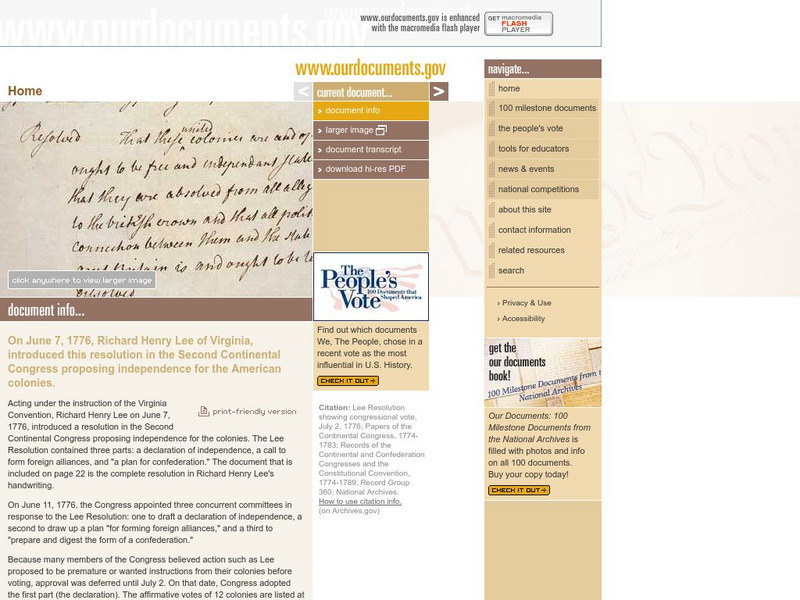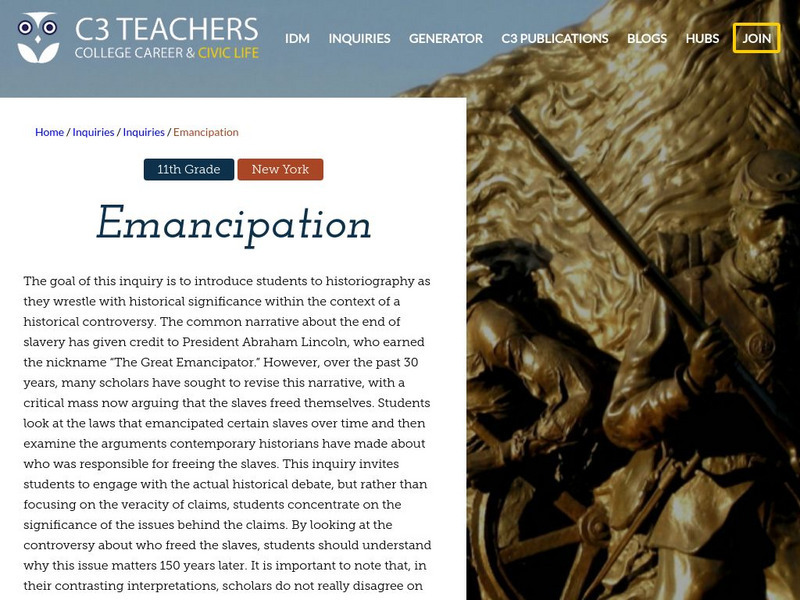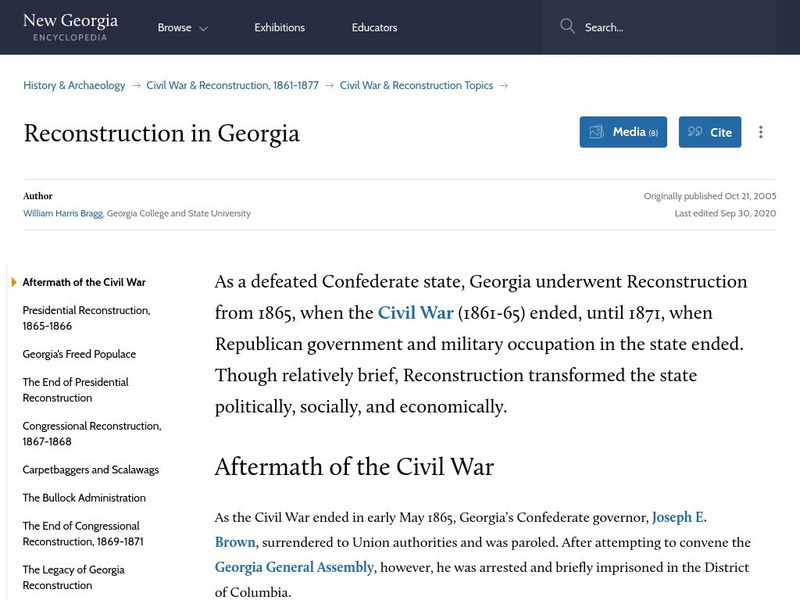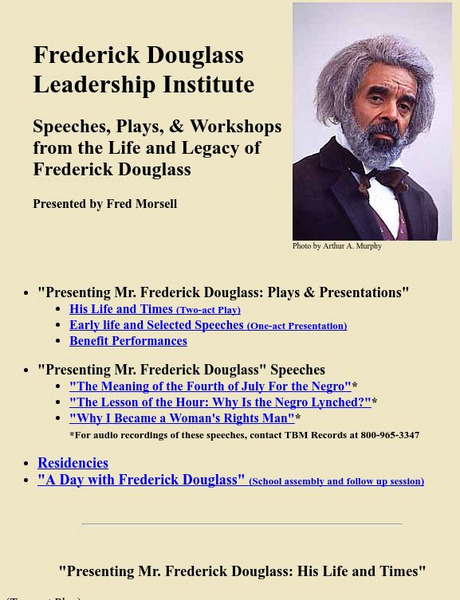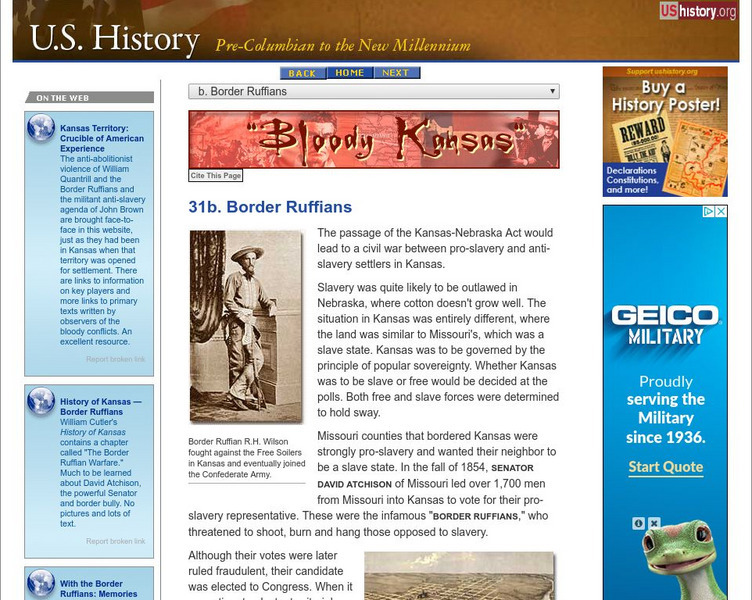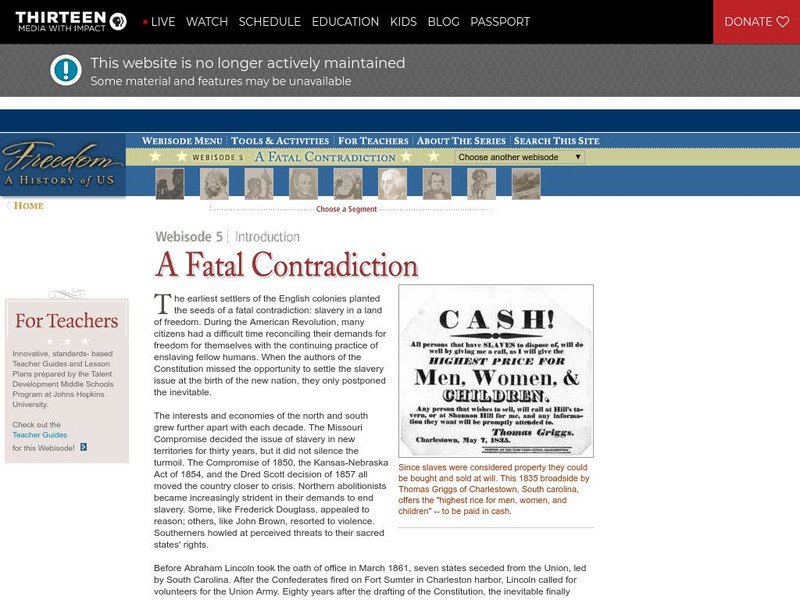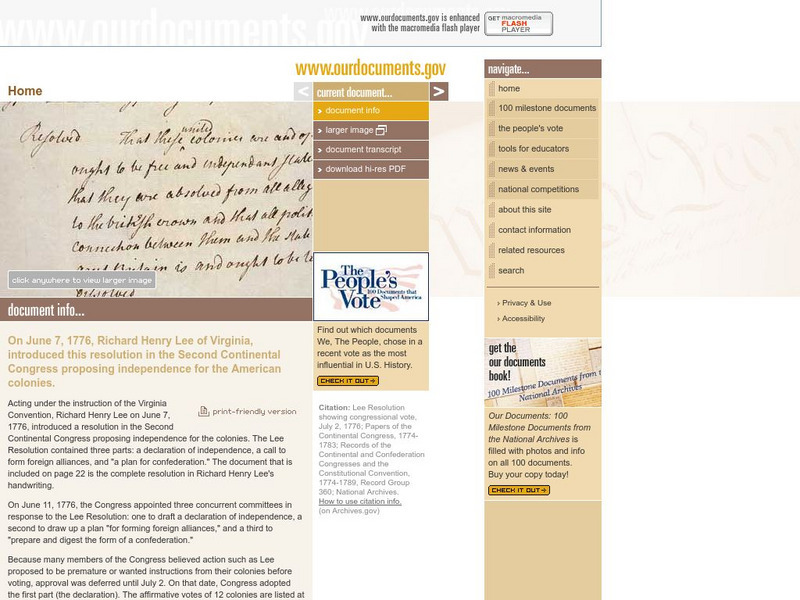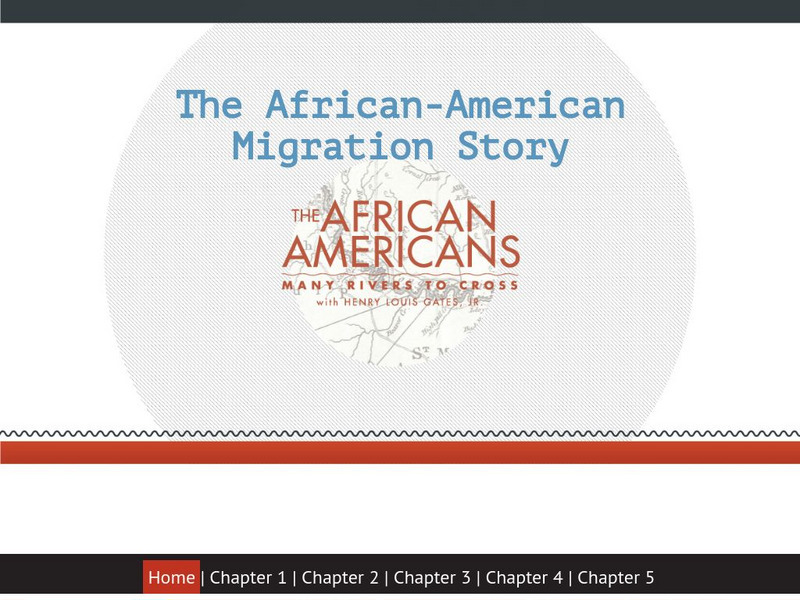Tom Richey
Tom richey.net: The Crisis of the Union (1850 1860) [Ppt]
Presents key ideas for examining the events and issues that led to the American Civil War.
Constitutional Rights Foundation
Constitutional Rights Foundation: Moving Toward Equality Under Law
As new free and slave states were admitted to the Union prior to the Civil War, political divisions kept growing, despite attempts to balance the numbers of each. The South pushed for slavery to expand westward, while anti-slavery...
University of Groningen
American History: Essays: The Black Lost Cause: Examples of Colored Service
African American slaves are known to have fought for the Confederacy during the Civil War, which many people may not realize. Why they would fight on the side of slavery, and the evidence that they did, are discussed in this section of...
Roy Rosenzweig Center for History and New Media
Teaching History: Ask a Historian: Senatorial Division
A discussion of how the political balance kept shifting as free and slave states were admitted to the Union prior to the Civil War.
Immigration and Ethnic History Society
Iehs: Katherine S. Carper, "Difficulty of Studying "Immigrants" in Early 19th C"
This article focuses on the study of immigrants in the early 19th century before the Civil War. Migration policy was primarily under state rather than federal control, and as long as slavery existed, there was no national definition of...
Digital Public Library of America
Dpla: Secession of the Southern States
This primary source set uses documents, illustrations, and maps to explore events and ideas that drove the formation of the Confederate States of America and the United States' descent into civil war. Includes a teacher's guide.
The History Cat
The History Cat: Reconstruction Era
Describes what the South was like after the Civil War ended. Many places were in ruins and people were desperately poor with many being homeless. Social structures had collapsed now that slaves had been freed. The Reconstruction era...
Other
John Brown Raid: 1859 Raid on Harpers Ferry
Commemorating John Brown's historic Harpers Ferry raid of 1859, this site has lots of information about Brown and the raid. The Educational Resources page is helpful for lesson materials. The links on the pressroom page will help you...
Have Fun With History
Have Fun With History: African Americans
Module on African Americans with links to National Underground Railroad Freedom Center Museum, Northwest African American Museum, and SuSable African American History Museum and numerous videos on various topics including, World War II,...
US National Archives
Our Documents: The Compromise of 1850
The Compromise of 1850 attempted to settle sectional disagreements about slavery in the volatile pre-Civil War period. The compromise, actually a series of bills, had an enormous impact on the nation's slow march to civil war. See...
C3 Teachers
C3 Teachers: Inquiries: Emancipation
A learning module on the emancipation of African American slaves after the Civil War. It includes several supporting questions accompanied by formative tasks and source materials, followed by a summative performance task. Students will...
CommonLit
Common Lit: "Narrative of the Life of Frederick Douglass" by Fredrick Douglass
Selected (11) reading passages (grades 7-11) to pair with the autobiography "Narrative of the Life of Frederick Douglass" by Fredrick Douglass. Frederick Douglass recounts his experiences as a slave in Maryland, and his treatment at the...
Georgia Humanities Council and the University of Georgia Press.
New Georgia Encyclopedia: Reconstruction in Georgia
After the Civil War ended, Georgia was in a state of chaos. Learn all about the Reconstruction in Georgia from 1865-1871 and how it changed the state politically, socially, and economically.
National Endowment for the Humanities
Neh: Edsit Ement: The Growing Crisis of Sectionalism in Antebellum America
In this Curriculum Unit, students will consider "The Growing Crisis of Sectionalism in Antebellum America: A House Dividing" in 4 Lessons. The unit also includes worksheets and other student materials that can be found under the resource...
Other
Presentations From the Life of Frederick Douglass
The actor Fred Morsell, a Frederick Douglass reenactor, provides plays about the 19th century civil rights leader as well as other resources about Douglass's life and work.
C-SPAN
American Writers: Harriet Beecher Stowe
An informational site on Harriet Beecher Stowe. Includes general information about her life, works, and writings, including Uncle Tom's Cabin. Also includes links to other sites.
Independence Hall Association
U.s. History: Border Ruffians
Because of the terms of the Kansas-Nebraska Act, a election would be held to determine whether Kansas would be a slave or free state. Read about the fraudulent votes cast by the so-called border ruffians from Missouri, and see how Kansas...
US Mint
U.s. Mint: One Cent Program: Lincoln 2.0 [Pdf]
In this four-part lesson, students identify and analyze the challenges that Abe Lincoln faced during his Presidency, including keeping the Union intact.
Art Institute of Chicago
Art Institute of Chicago: Art Access: American Art to 1900
Study works of American art from the eighteen and nineteenth centuries. Works in a variety of media, including the decorative arts, are represented as are pieces by some of America's best-known artists: Copley, Church, Homer, and...
PBS
Wnet: Thirteen: Freedom: A History of Us: A Fatal Contradiction Webisode 5
Webisode 5 - A Fatal Contradiction. The history of the United States is presented in a series of webisodes, within each are a number of segments.Included are links to lesson plans, teacher guides, resources, activities, and tools.
Digital History
Digital History: From Slave Labor to Free Labor
The most difficult task confronting many Southerners during Reconstruction was devising a new system of labor to replace the shattered world of slavery. Learn how plantation owners and freed slaves adapted to this massive shift in the...
US National Archives
Our Documents: The Kansas Nebraska Act
An outstanding, interactive copy of the Kansas-Nebraska Act, the legislation that repealed the Missouri Compromise. Historical context included, as well as links to larger images, a typed transcript, and a downloadable PDF file.
C3 Teachers
C3 Teachers: u.s. History Module: Did Lincoln Really Want to Free Slaves? [Pdf]
A comprehensive learning module on Abraham Lincoln that includes three supporting questions accompanied by formative tasks and primary source materials, followed by a summative performance task. Students examine the evolution of...
PBS
Pbs: African American Migration Story: Many Rivers to Cross
A detailed presentation illustrating the history of Africans migrating to the Americas from as early as 1500 through the late 1860's. Review the distribution of Africans in North and South America, the initial settlements, escaped and...
![Tom richey.net: The Crisis of the Union (1850 1860) [Ppt] PPT Tom richey.net: The Crisis of the Union (1850 1860) [Ppt] PPT](https://static.lp.lexp.cloud/images/attachment_defaults/resource/large/FPO-knovation.png)





